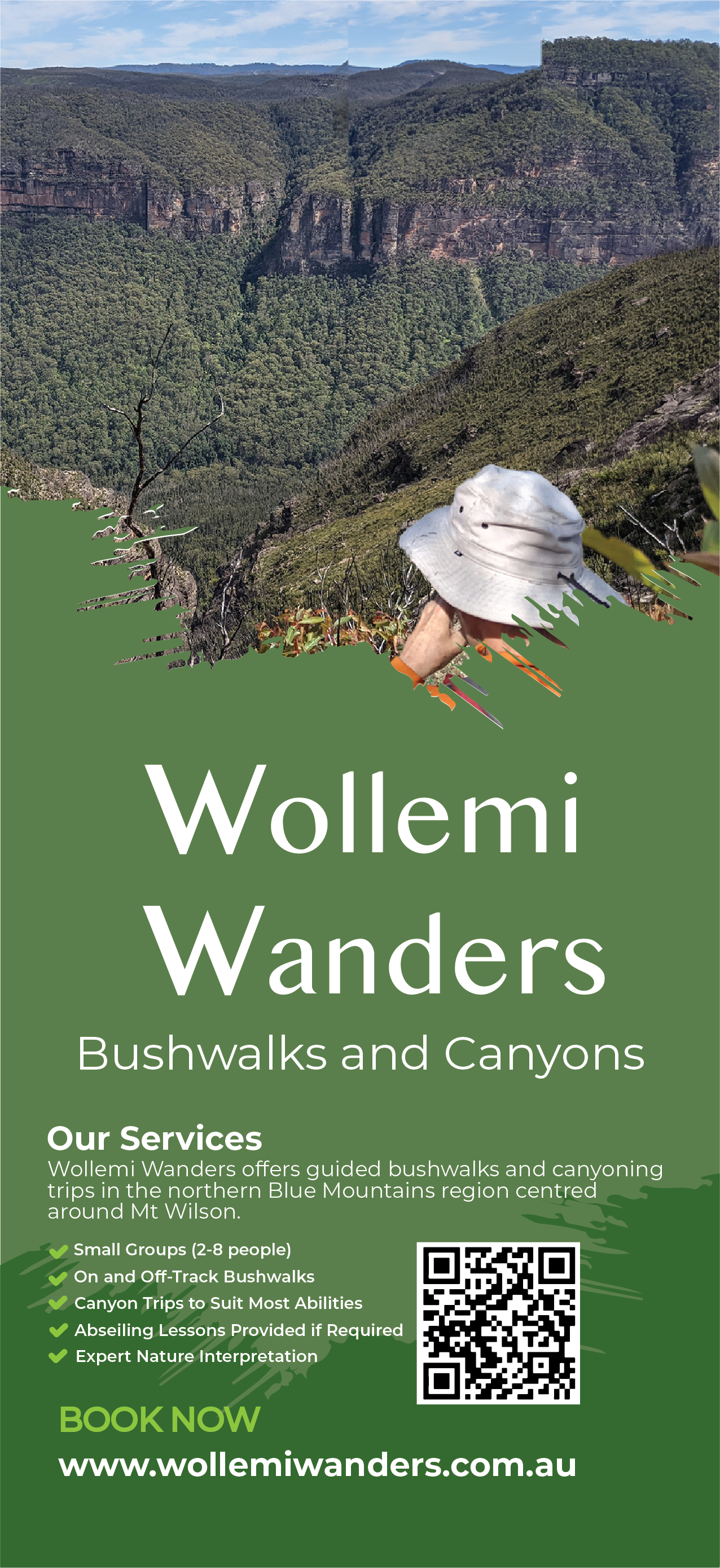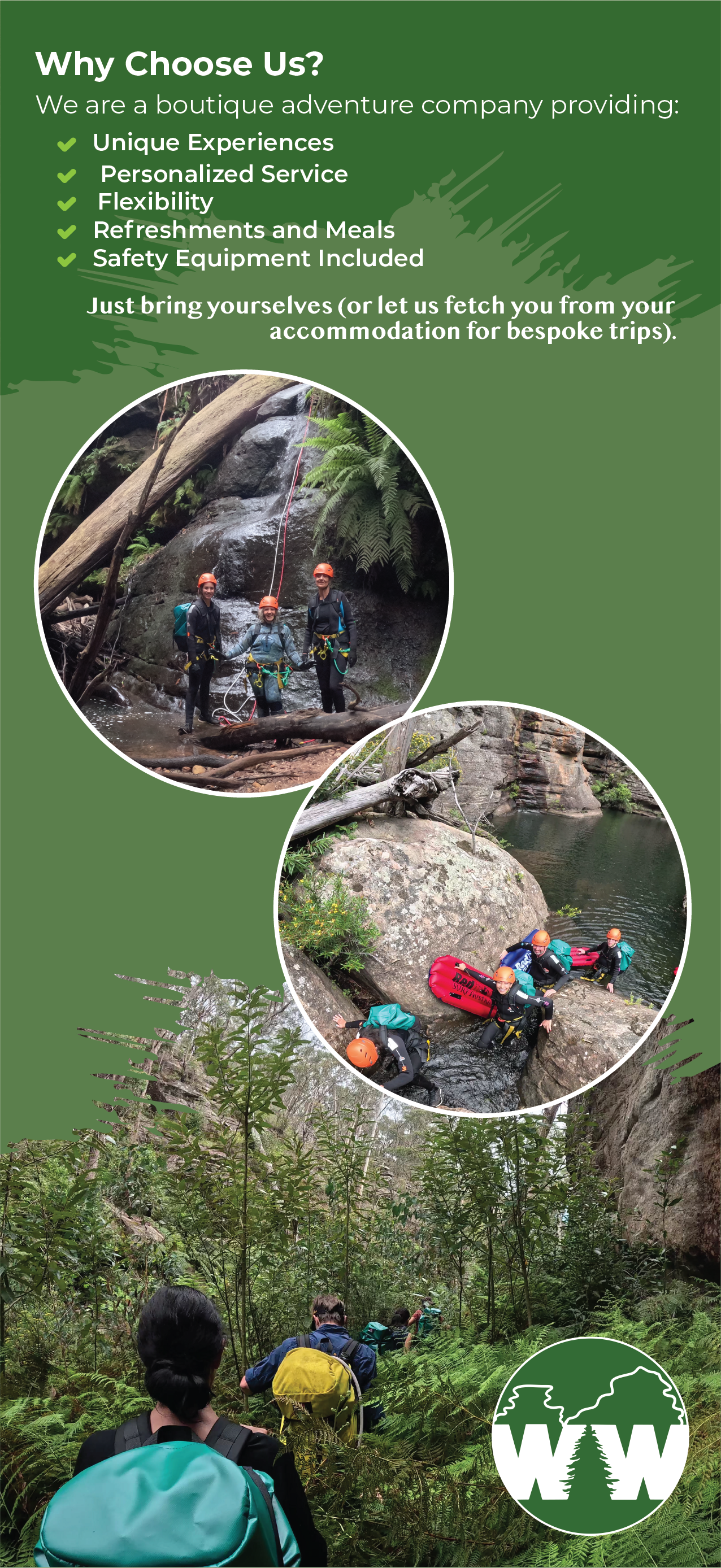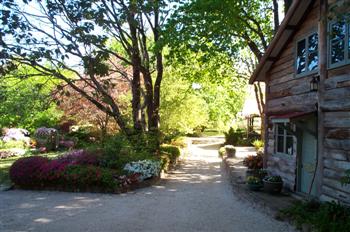Uncategorised
Kashmir
- Details
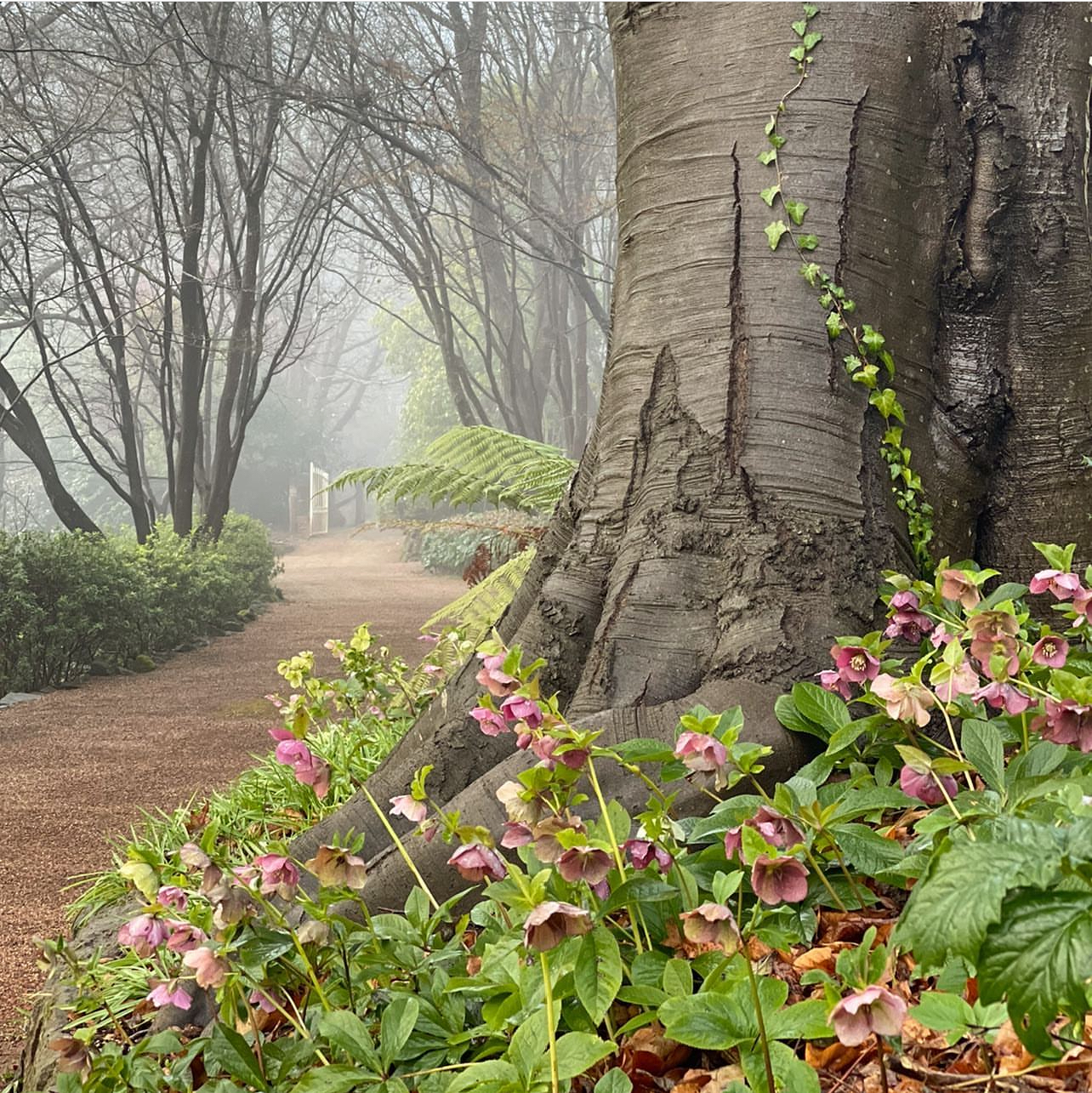 "Kashmir", formally known as "Koojanup Park", is now open for visitors on weekends during Spring and Autumn.
"Kashmir", formally known as "Koojanup Park", is now open for visitors on weekends during Spring and Autumn.
Woodfired pizzas and drinks are also for sale at the trailer at the entrance to the garden.
Located at 10 Church Lane, the garden is approximately 25 acres and growing. For more information see: https://www.kashmirmountwilson.com.au/
Mrs Rodgers commissioned Paul Sorensen to design and do the works on the property which included terracing and basalt stonework.
Maples, cherry's, elms and oaks can be found along with Tulip and birch trees, rhododendrons and camellias. There are a number of conifers and Cypress, including a large Sequoia sempervirens.
Since purchase almost 5 years ago , the current owners have worked at restoring the garden which had become overgrown and required maintenance to the stonework.
Along with restoring and maintaining the garden, current work has included adding basalt stone walls and several sets of sandstone stairs in order to aid in the flow of the garden. The design has always intended to carry the Sorensen style throughout.
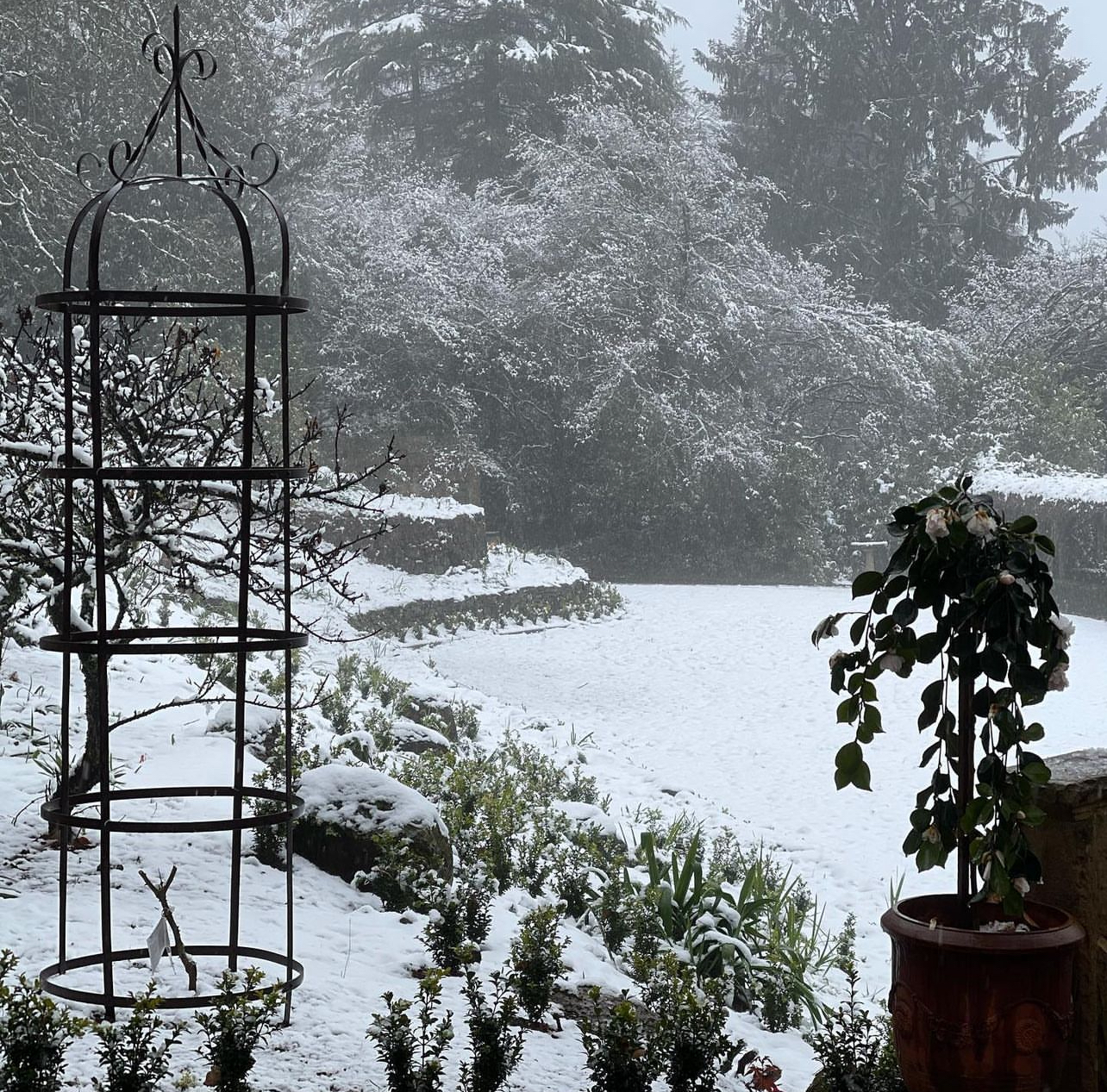 You'll find new plantings of several types of
You'll find new plantings of several types of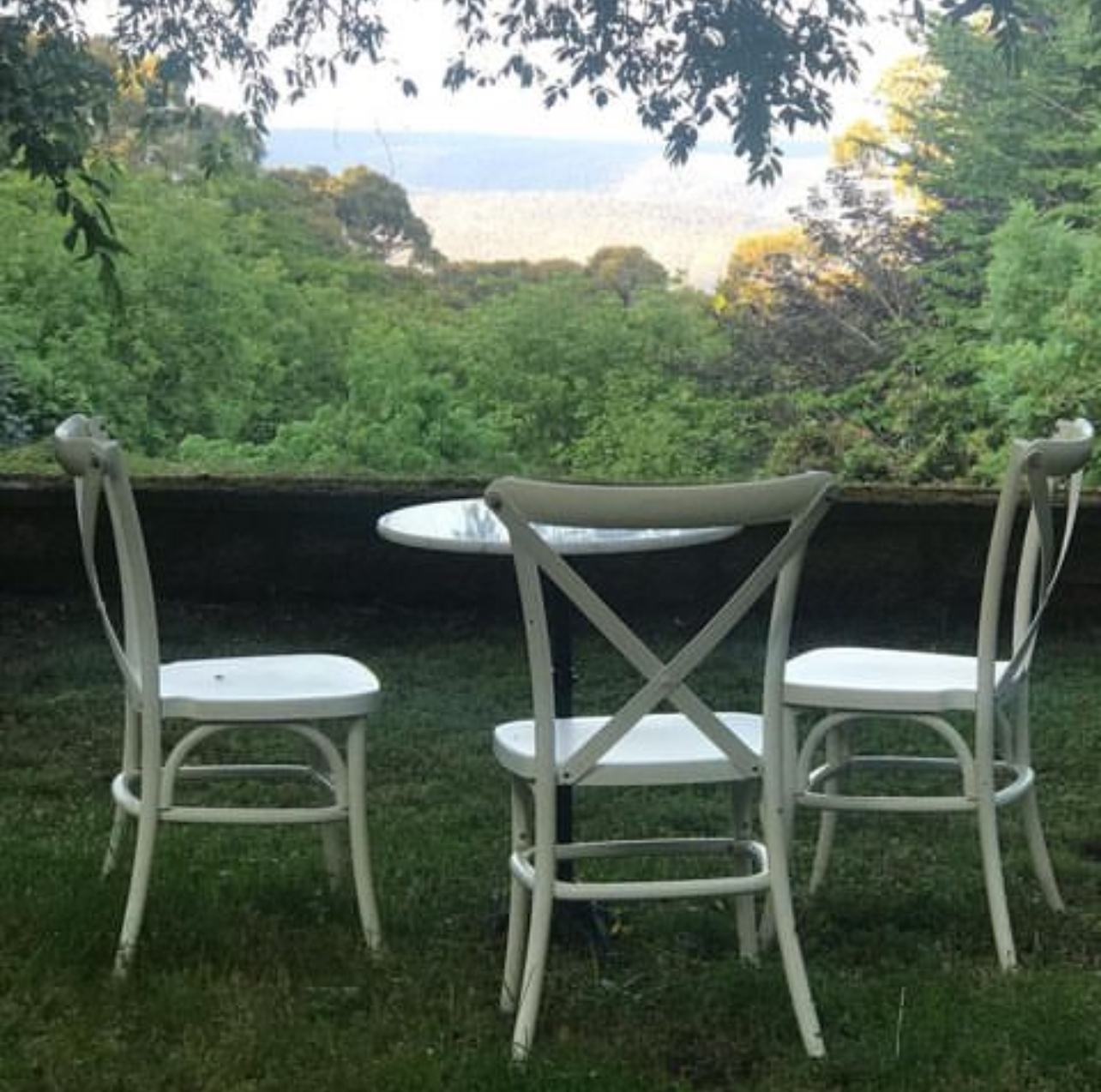 hydrangea and peonies along with hundreds of bulbs planted each year for Spring.
hydrangea and peonies along with hundreds of bulbs planted each year for Spring.
The garden will be ready to open fully in Spring 2024. Currently, the terraces are open to visit free of charge.
You will find the owners son, Chad, making woodfired pizzas from his trailer on the top terrace. There are plenty of places to sit and eat and enjoy the wonderful view.
Hope to see you there!
Historical Walk
- Details
Mt Wilson Historic Village Walk - Mobile App
The Mt Wilson Historic Village Walk mobile app is available for you to download from both the Apple and Google Play app stores.
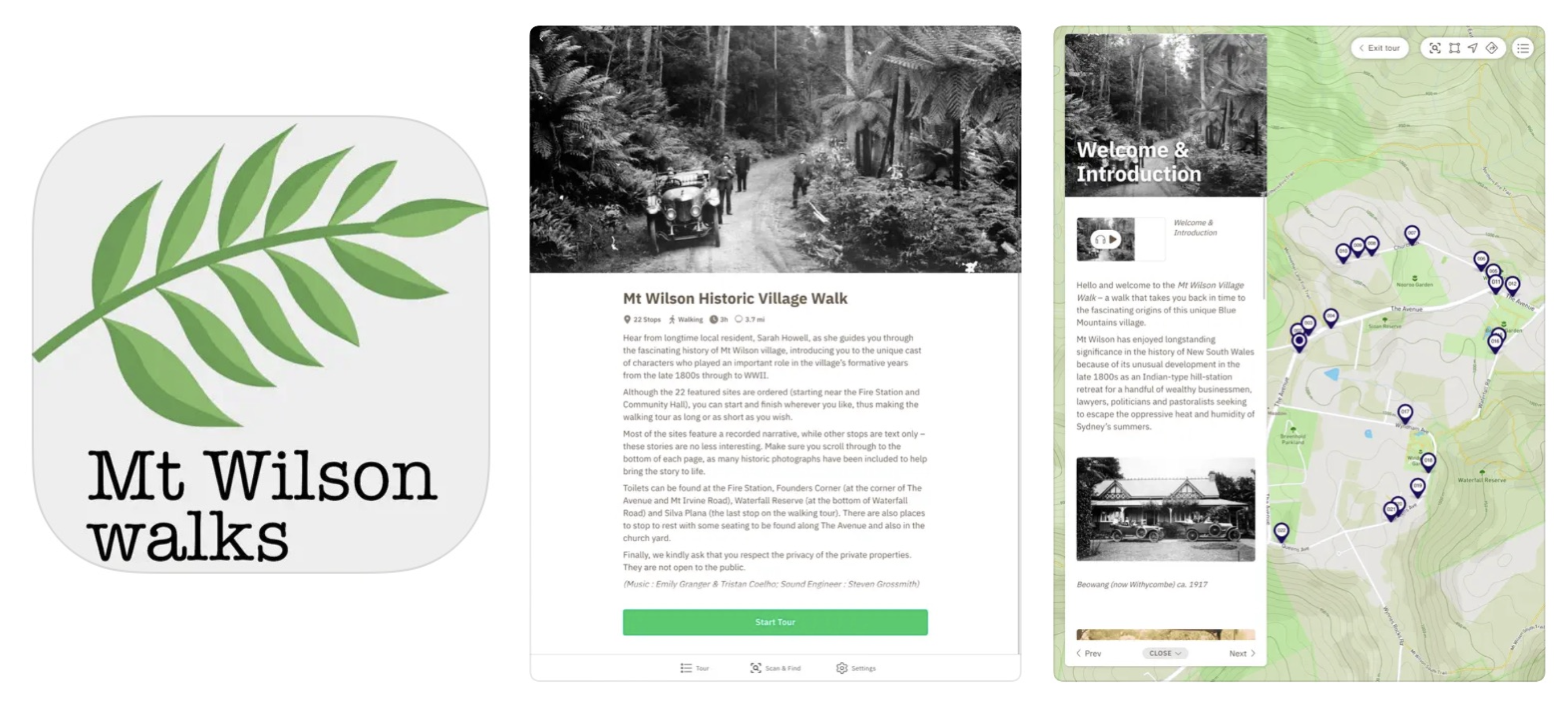
There is no better way to enjoy the splendour of Mt Wilson than to take this GPS-based audio-visual tour of Mt Wilson as you are guided you through the fascinating and often entertaining history of Mt Wilson village, introducing you to the unique cast of characters who played an important role in the village’s formative years from the late 1800s through to WWII.
- GPS-enabled, guiding you from stop-to-stop
- 22 individual historical sites of interest
- 15 audio-recorded narratives
- Historical photographs from the Society’s archives included throughout
Reasonably priced at $3.99, net proceeds go directly to the Historical Society, helping to support the subscription costs associated with keeping the app going.
Download Now:
Monitor Fire Trails While Walking
- Details
Help By Monitoring Fire Trail Condition While Walking
In late 2021 David Howell, Senior Deputy Captain encouraged the Brigade members and the community to walk fire trails in their own time and report any hazards, such as fallen trees, branches or other obstacles which might impede the safe passage of fire trucks or firefighters. As a result, he has developed a system to allow each person to report any problems located on any trail into a spreadsheet.
To access this spreadsheet please use this link and bookmark or save it for future use. You may find you will be asked for a sign in, just click on the link again.
There are some considerations to contemplate which are important. You have the option of walking trails taking normal personal responsibility and then reporting anything you find which causes concern by using the link above to access the Fire Trails spreadsheet and enter a brief description of any concerns observed.
Or, if you are a Brigade member, you can regard this as a Brigade task attracting the usual RFS protections when we undertake RFS undertakings. If you wish to regard it as a Brigade task:
- You must sign in on the attendance book at the Mt Wilson or Mt Irvine Station. Members should know how to access the building from previous briefings. If in doubt, please ask a senior officer.
- Contact David Howell on (This email address is being protected from spambots. You need JavaScript enabled to view it.), or phone 4756-2091 or 0418 771 664 providing the following details:
- When you’re heading off - advising him what trail you’re walking, start time and estimated finish time, who’s in your party.
- If you see a fallen tree, branch or other hazard/obstacle make a note, take photos if you can and make a record of the location of the hazard/obstacle(s).
- Importantly, when you complete your walk, call or text David to let him know that you’ve safely completed your tasking.
- Use the link to access the Fire Trails spreadsheet and enter a brief description of any concerns observed.
If you see a tree or branch over the trail, please don’t attempt to remove it unless it is small and light enough to do so safely by hand. Once you report any large tree hazard, the Brigade will arrange for a member certified to use a chainsaw to remove it or if very large, have Council remove it.
One suggestion made was that members might like to monitor a particular fire trail. Even though this means we’ll have some regular fire trail walkers, that doesn’t mean that others can’t use those trails. We encourage members and the community to familiarise themselves with ALL fire trails. The Brigade would like all fire trails to be monitored at regular intervals – say, 6-8 weeks to ensure that we have current information
Any specific questions on this type of tasking please contact David or another senior officer.
After Emergency Support
- Details
Following all emergencies people are impacted and need support. This can be in the form of psychological or social support. Contact details are available below, but if you need someone to talk to or are feeling anxious or depressed then please contact one of the organisations below.
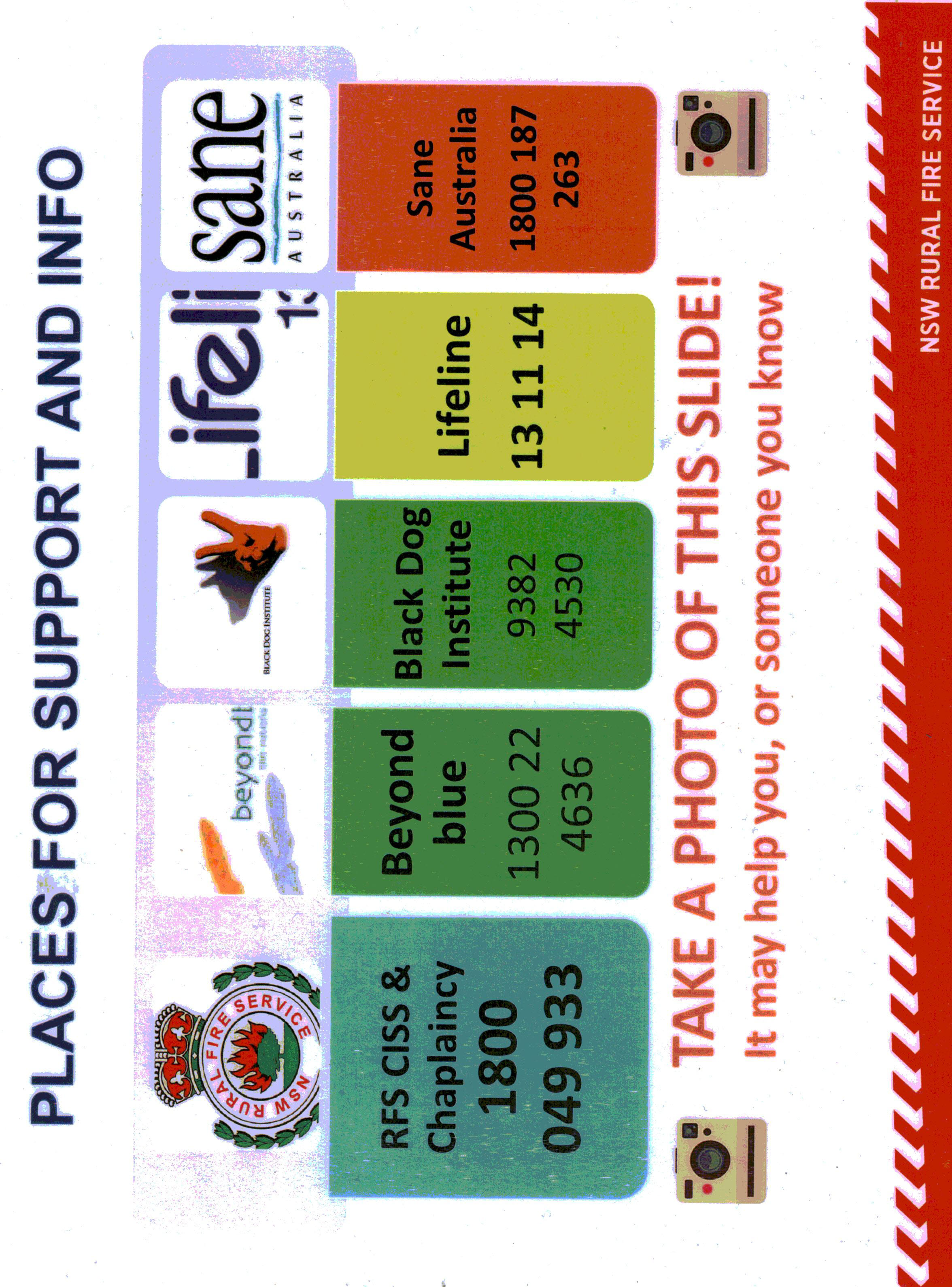
2021 Newsletters
- Details
February 2021
pdf Under and Overcliff at Wentworth Falls February 2021 (443 KB)
March 2021
pdf Ikara Ridge and Ikara Head at Mt Victoria March 2021 (431 KB)
April 2021
pdf Hat Hill to Anvil Rock at Blackheath April 2021 (413 KB)
May 2021
pdf Transit of Venus Track at Woodford May 2021 (428 KB)
June 2021
pdf Asgard Swamp and Thor Head at Mt Victoria June 2021 (426 KB)
July 2021
pdf Cancelled Leura Lookouts Walk July 2021 (441 KB)
August 2021
pdf Cancelled Leura Lookouts Walk August 2021 (427 KB)
September 2021
pdf Cancelled Leura Lookouts Walk September 2021 (429 KB)
October 2021
pdf Cancelled Leura Lookouts Walk October 2021 (434 KB)
November 2021
pdf Jinki Ridge near Mt Wilson November 2021 (432 KB)
December 2021
pdf Waterfalls, Logging Trails, The Mill and Daintree Lane at Mt Wilson December 2021 (443 KB)
White Jasmine (Jasminum polyanthum)
- Details
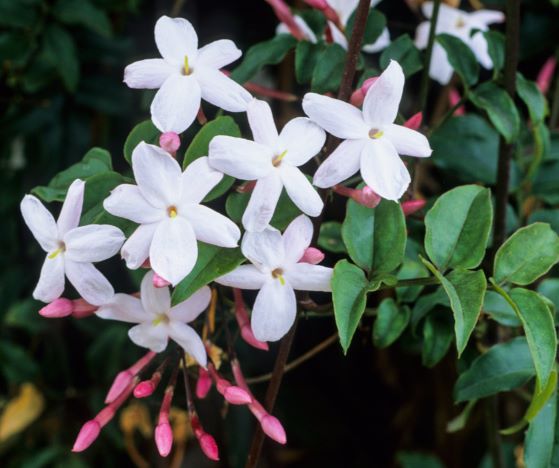 Jasmine provides a very scented and pretty creeper but this needs to be controlled as Jasmine is a serious weed in the Rainforest.
Jasmine provides a very scented and pretty creeper but this needs to be controlled as Jasmine is a serious weed in the Rainforest.
Type of weed: Climber, scrambler or groundcover
Flowering Months: September, October, November
Native of China. A fast growing evergreen climber with small shiny green leaves and white flowers which are pink in bud and sweetly scented. Jasmine spreads by self-layering and occasional setting of seed. It can seriously threaten the rainforest edges of Mt Wilson. This plant has become a big problem in some gardens.
Alert: The flowers can cause allergies in some people.
Don’t confuse with… Jasmine can be confused with native Wonga Wonga Vine (Pandorea pandorana) before the plant develops the distinctive lobed leaves and before it flowers.
Impact on bushland
Jasmine climbs rapidly into the tree canopy and covers vegetation at all levels, blocking light and restricting the growth and regeneration of native species. Its weight may bring down branches. It is a serious weed of rainforests.
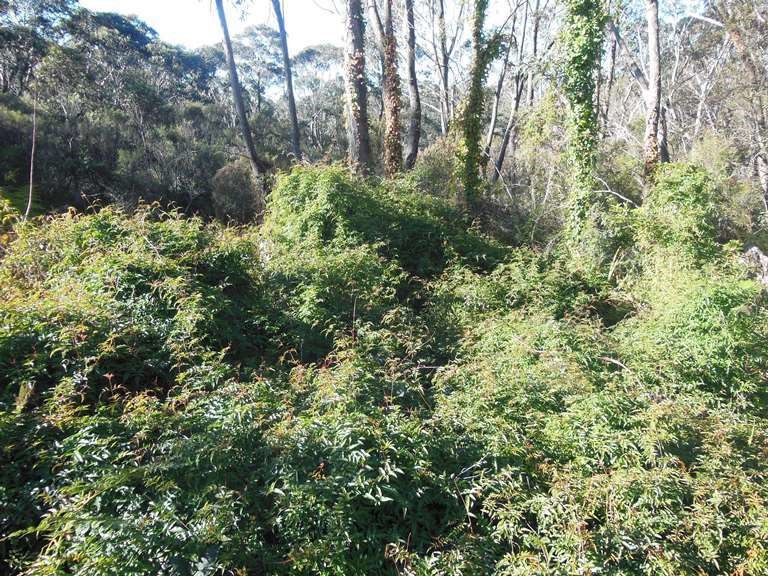
Prevention
- Keep well pruned
Control
Because of the fine twining stems and vigorous nature of this plant it is hard to eradicate.
- Dig out or spray December to March.
- Scrape and paint stems.
- If the vine has grown up into the canopy of a tree or shrub, cut each of the vine stems about 500 mm above the ground, after scraping and painting above and below the planned cut, to allow the parts in the tree canopy to die. It is important to keep the cut low to allow adequate length of the stems to be reached for re-treatment.
Alternative native plantings
- Twining Purple Pea (Hardenbergia violacea)
- Wonga Wonga Vine (Pandorea pandorana)
- Water Vine (Cissus antarctica)
- Old Man’s Beard (Clematis aristata) - note: not Clematis cultivars as these can also be environmental weeds.
Japanese Honeysuckle (Lonicera japonica)
- Details
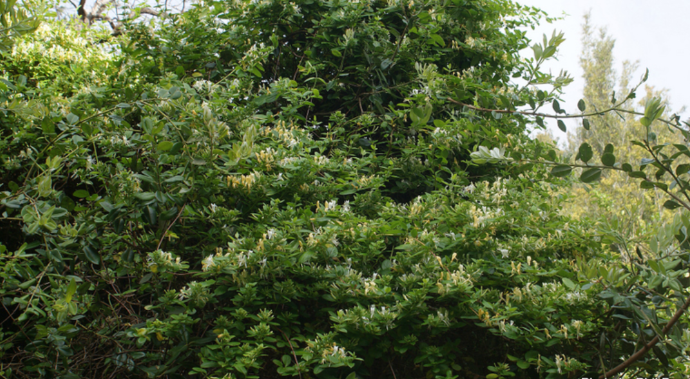 A native of China and Japan. Japanese Honeysuckle is a vigorous climber with soft green leaves and pale yellow, sweetly scented flowers which self layers and quickly grows up and over shrubs and small trees, smothering them. The black berries are carried by the birds.
A native of China and Japan. Japanese Honeysuckle is a vigorous climber with soft green leaves and pale yellow, sweetly scented flowers which self layers and quickly grows up and over shrubs and small trees, smothering them. The black berries are carried by the birds.
Japanese Honeysuckle is a vigorous, fast growing scrambling and climbing shrub with distinctive pinkish new stems. Old stems can become thick and gnarly.
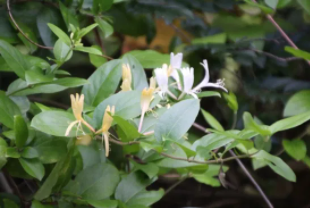
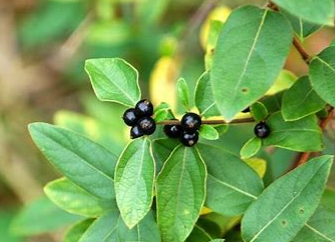 Spring is a good time to identify Japanese Honeysuckle, a creeper with its distinctive small yellow cream to white flowers with a pink tube. Flowers occur in pairs and mostly in spring to autumn. Flowers are fragrant and nectar-filled.
Spring is a good time to identify Japanese Honeysuckle, a creeper with its distinctive small yellow cream to white flowers with a pink tube. Flowers occur in pairs and mostly in spring to autumn. Flowers are fragrant and nectar-filled.
Small shiny black berries 6–10 mm long occur in autumn.
Impact on bushland
Japanese Honeysuckle grows rapidly and forms a dense shade over shrubs and low canopy trees, blocking the light, breaking branches and causing loss of biodiversity.
Control
Japanese Honeysuckle twines in and around other plants, making it difficult to control.
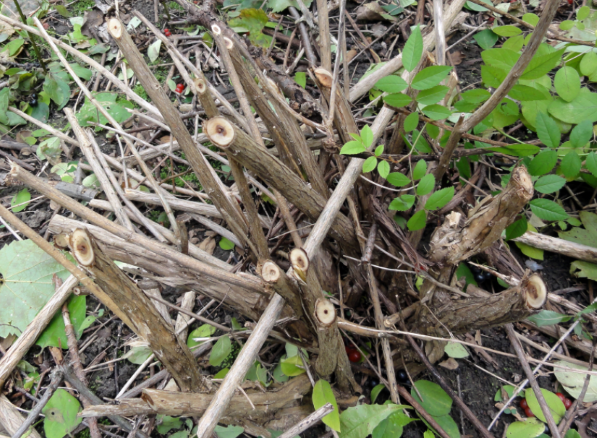
Vines climbing up shrubs or trees:
- Scrape each stem as far as possible and paint; suspended vines can then be cut and left in place.
- Suspended vines are easily identified as they look like gnarly paperbark vines.
- Cut and paint large crowns and scrape and paint as many roots as possible.
Vines growing on the ground:
- Pull out by hand, making sure all root and stem parts are removed. Cut material can be spread out off the ground. Once dead, it will decompose in place.
- Where the foliage is dense, treat with herbicide if there are no native plants or water nearby.
Berries are spread by birds, so treat plants before they fruit.
Do not pull dead or alive vines out of trees as this may damage the tree and it may be habitat for microbats and other small animals.
Stinking Iris (Iris foetidissima)
- Details
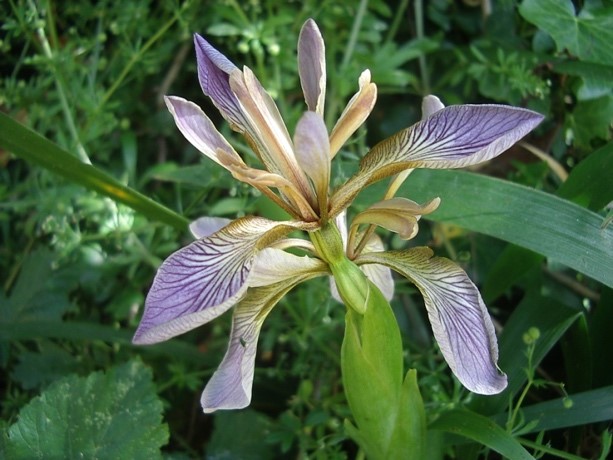 Flowering from November on The Mounts is Iris foetidissima also known as “Stinking Iris” or “Roast Beef Plant” after its rather unpleasant fragrance when cut or bruised.
Flowering from November on The Mounts is Iris foetidissima also known as “Stinking Iris” or “Roast Beef Plant” after its rather unpleasant fragrance when cut or bruised.
It is a clump-forming evergreen herb to 100 cm, with tough rhizomes immediately below the soil surface.
The flowers are 5–7 cm in diameter and are dull purplish-grey tinged with yellow. More common in Australia is the yellow flowered variant that is often naturalised. You will find both varieties flowering in Mt Wilson currently.
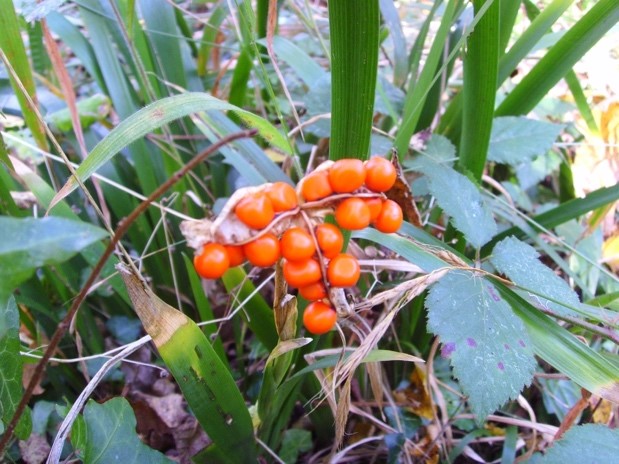
At maturity each seed capsule splits into three, each with two rows of round orange seeds of 5 mm diameter, these can persist for several months.
Despite the Royal Horticultural Society giving Iris foetidissima their prestigious Award of Garden Merit. The plant is clearly becoming a problem in Mt Wilson, most notably in and around Church Lane. Each plant grows rapidly and seeds readily and is dispersed by birds. Mature stands will easily smother a garden bed and become extremely difficult to remove.
There are three options to manage this plant:
- If you wish to retain any plants, systematically remove any seed capsules before the seeds emerge.
- To remove the plants, the most effective way is to mattock out the rhizomes (juvenile plants can usually be removed by hand.
- Iris foetidissima will respond to Glyphosate (RoundupTM) but the leaves will need to be soaked and secondary spraying may be required.
Himalayan Honeysuckle (Leycesteria formosa)
- Details
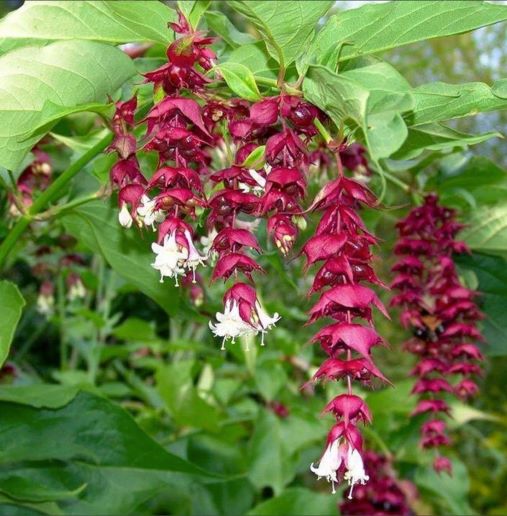 Himalayan Honeysuckle invades sensitive moist bushland such as Blue Mountains swamps where it forms thickets and dense shade, displacing native vegetation.
Himalayan Honeysuckle invades sensitive moist bushland such as Blue Mountains swamps where it forms thickets and dense shade, displacing native vegetation.
A deciduous multi-stemmed shrub to 3 m high. Stems are erect, hollow and bamboo-like. A native of the Himalayas. Leycesteria is a vigorous arching shrub with large, soft green leaves and drooping panicles of white flowers which are followed by clusters of shining dark purple berries spread in December and January by the birds. These plants grow well in the semi-shade of the rainforest.
Fruits are ovoid fleshy berries, dark crimson when ripe. Each fruit contains more than 100 small seeds.
Control
- The plant should be fully and continuously suppressed and destroyed
- Dig out, or cut off and poison every stem.
- Spray large areas November to March.
Common Holly (Ilex Aquifolium)
- Details
After English Ivy, Common Holly is the most ubiquitous weed in Mt Wilson.
There are many old established Holly Trees and hedges in Mt Wilson. Whilst owners may be reluctant to remove these, care should be taken to stop the spread of Holly trees. Holly gets established very quickly and it is easiest to remove when the plants are still small. When they are seedlings they can sometimes be dug up as long as all roots are removed. Holly cuttings should all be placed in the green bin, mulched or burnt as they reshoot very easily.
The extract below is from Libby Raines weed booklet.
A native of Europe to China and North Africa. Holly is a large fast growing evergreen shrub (a small tree on Mount Wilson). It has very prickly shining green leaves and many red berries in the Autumn, which are carried by the birds. Each berry contains up to four seeds, which germinate readily in our ideal conditions, especially in the shade, and they quickly make a large self-layering shrub which usually shades out everything else around it.
Holly can be seen almost everywhere you walk on good soil. Holly and Ivy are the two most serious weeds on Mount Wilson. It is heartening to see many land owners removing holly trees from their properties.
The variegated forms of Holly are suitable to grow.
Control
- Pull or dig out small plants or spray December to March.
- Large plants cut off and poison.
Resources
Blackberry (Rubus fruticosus agg spp)
- Details
Declared a noxious weed.
A native of Europe. Blackberry is an erect scrambling perennial shrub with long arching thorny canes which grow up to 2-3 metres (6ft-10ft) in height and are deciduous on Mount Wilson and Mount Irvine. The many white flowers are followed by berries which are green, turning red then black as they ripen in February and March.
The berries which contain the seeds are spread by birds all over the Mountain and quickly form new plants in ideal conditions. The canes will also grow by suckering, so a large dense prickly bush will soon form.
A combined effort by landowners and the Council is now needed annually to control Blackberry on some private land where it is a big problem, causing continual reinfestation of the reserves and roadsides.
Control
- Dig out small plants.
- Spray fruiting plants November to January, non-fruiting plants up to March.
- Cut crown and poison: For mature plants with a woody crown (root ball) – the cut crown method is very effective. It involves removing soil from the base of the plant where it's coming from the ground and cutting through the crown at the widest point to create maximum surface area to apply herbicide.
- Scrap and Paint: For all other plants - seedlings, juvenile and mature without accessible root crown, scrape and paint canes. Paint every stem for 300mm (8in- 12in) of its length
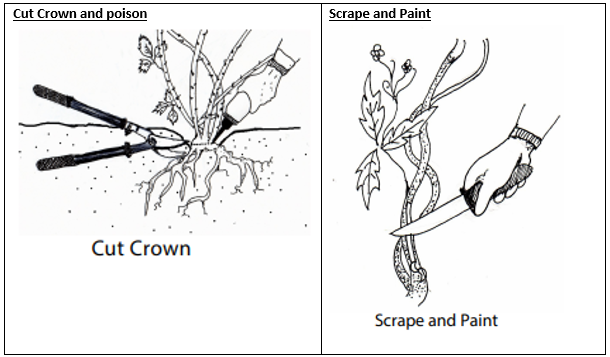
Herbicides
- Spray - Tree and Blackberry killer
- Paint - Tree and Blackberry killer or Glyphosphate (Roundup)
Please note special care must be taken when using herbicides and especially Glyphosate. The MWPA accepts no responsibility for the use or application of any chemicals. Always check the labels and Safety Data Sheets for all chemicals and use only as directed. For more details on herbicides refer to the additional information sources below.
Useful Sources of Information:
English Ivy (Hedera helix)
- Details
Whilst English ivy (Hedera helix) provides some lovely features and screens in our gardens this is very aggressive when out of control.
The Dandenong Ranges in Victoria (see video) are similar to Mt Wilson/Mt Irvine with the basalt soil and ornamental gardens and have a similar problem to the mounts with Ivy growing up trees and sometimes enveloping the whole tree.
Ivy is rampant in the village and eradication is difficult. However, we can all do something to limit the spread of ivy. Ivy flowers and produces fruit when it climbs up a tree and the seeds are then carried into gardens and the bush by birds. English ivy will eventually choke and kill trees, even big ones, both natives and exotics. To stop it spreading we need to focus on ivy growing on trees.
Tree Fern Treatment
For tree ferns the task is more complex as the ivy roots grow into the trunk. To kill the ivy the stems must be scraped with a knife and the herbicide applied to the ivy stem wound, being careful to avoid the tree fern trunk. This is best done in the growing season October to end April.
Non Tree Fern Tree Treatment
For other trees the process is much easier. Just cut the Ivy at the base and the Ivy should die. It is best also clearing about 1 m from the base of the tree. (see video)
Herbicide
Glyphosate (Roundup) is a herbicide that is used for killing English Ivy. Please note special care must be taken when using Glyphosate. The MWPA accepts no responsibility for the use or application of any chemicals. Always check the labels and Safety Data Sheets for all chemicals and use only as directed.
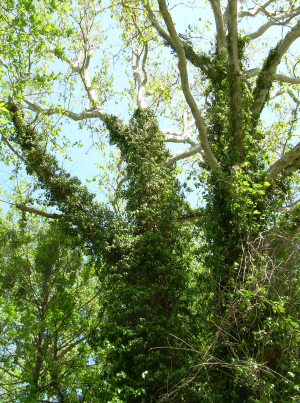 Please note that the Blue Mountains Basalt Forest in around Mt Wilson is a ‘Blue Mountains Sensitive Vegetation Community’ so extreme care needs to be taken when controlling weeds in bushland areas. The only weed control methods recommended in sensitive areas are ‘scrape and paint’, ‘cut and paint’ and ‘stem injection’. If in any doubt about how to control weeds on your property consider using an accredited weed control contractor.
Please note that the Blue Mountains Basalt Forest in around Mt Wilson is a ‘Blue Mountains Sensitive Vegetation Community’ so extreme care needs to be taken when controlling weeds in bushland areas. The only weed control methods recommended in sensitive areas are ‘scrape and paint’, ‘cut and paint’ and ‘stem injection’. If in any doubt about how to control weeds on your property consider using an accredited weed control contractor.
Other Usefull references:
Weedwise Weed of the Month - English Ivy
Weedwise - English Ivy - Best Practices
WikiHow - How to kill English Ivy
Birds in Mt Wilson
- Details
Ducks and swans
Australasian darter
Herons and egrets
White-necked heron
Ibises and spoonbills
Straw-necked ibis
Masked lapwing
Eagles, kites and goshawks
Brown goshawk
Grey goshawk
Wedge-tailed eagle
Pigeons and doves
White-headed pigeon
Brown cuckoo dove
Common bronzewing
Brush bronzewing
Crested pigeon
Bar-shouldered dove
Wonga pigeon
Cockatoos
Yellow-tailed black cockatoo
Gang-gang cockatoo
Parrots and lorikeets
Galah
Rainbow lorikeet
Australian king parrot
Crimson rosella
Eastern rosella
Cuckoos
Fan-tailed cuckoo
Shining bronze-cuckoo
Horsfield’s bronze-cuckoo
Channel-billed cuckoo
Owls
Powerful owl
Southern boobook
Sooty owl
Eastern barn owl
Frogmouths and nightjars
Tawny frogmouth
Kingfishers
Azure kingfisher
Laughing kookaburra
Superb lyrebird
Treecreepers
White-throated treecreeper
Red-browed treecreeper
Fairy-wrens
Superb fairy-wren
Variegated fairy-wren
Pardalotes
Spotted pardalote
Scrubwrens, thornbills and gerygones
Pilotbird
Rockwarbler
Yellow-throated scrubwren
White-browed scrubwren
Large-billed scrubwren
Brown gerygone
Brown thornbill
Striated thornbill
Honeyeaters
Red wattlebird
Little wattlebird
Bell miner
Lewin’s honeyeater
Yellow-faced honeyeater
White-eared honeyeater
White-naped honeyeater
Crescent honeyeater
New Holland honeyeater
Tawny-crowned honeyeater
Eastern spinebill
Jacky winter
Australian robins
Scarlet robin
Red-capped robin
Flame robin
Rose robin
Eastern yellow robin
Eastern whipbird
Whistlers and allies
Golden whistler
Grey shrike-thrush
Crested shrike-tit
Black-faced monarch
Fantails
Grey fantail
Rufous fantail
Willie wagtail
Cuckoo-shrikes
Black-faced cuckoo-shrike
Currawongs and allies
Grey butcherbird
Pied butcherbird
Pied currawong
Grey currawong
Australian magpie
Ravens and crows
Australian raven
White-winged chough
Satin bowerbird
Finches
Red-browed finch
Mistletoebird
Swallows and martins
Welcome swallow
Tree martin
Fairy martin
Songlarks
Rufous songlark
Brown songlark
Silvereye
Bassian thrush
Introduced birds
Red-whiskered bulbul
Common blackbird
Common starling
Donating to Mt Wilson - Mt Irvine Community Groups
- Details
Tax deductible donations can be easily made by clicking on the following links below:
The Mt Wilson - Mt Irvine Rural Fire Brigade
Current Bushfire Status
- Details
Update about the Gospers Mountain Fire to the north of us, posted Wednesday, 11 December.
Gospers Mountain Bushfire Update - Plan to begin backburning today.
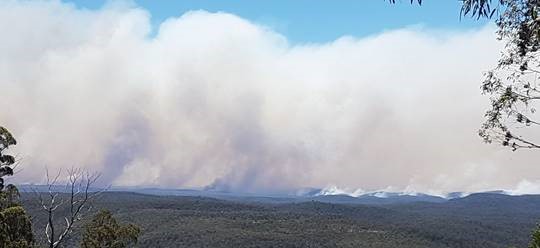
The Gospers Mountain bushfire seen yesterday from Smiths Hill was about 6 kms from Mount Irvine
The Fire
While we have a good weather window MWMIRFS Brigade will commence back burning into the area below Mount Irvine today to take advantage of the better conditions for creating a safety burnt area around Mt Irvine. This will involve lighting the bush from the fire trails around Mount Irvine then Mount Wilson to remove the fuel between the villages and the Gospers Mountain fire thereby protecting property in the villages. The back burn is a lower intensity burn usually lit at night and going downhill so as to reduce the impact on the surrounding bush while removing the fuel and protecting the area from the bushfire coming into the villages on a bad day.
On Tuesday the fire was holding on Bungleboori Creek (see yesterday’s Update map), north of Mt Wilson / Mt Irvine, but quite active on the Newnes Plateau. The back burn started at Mountain Lagoon has progressed as far as Bilpin. After a very hot day yesterday we are entering a good weather window until about Friday.
Access to the Mounts
A road block at Mt Wilson Road and the Bells Line of Road will restrict access to all vehicles other than residents and emergency services. Expect this to be in place for a couple of weeks.
Letters of authority were distributed last night to all residents providing access to named people on the presentation of the letter and ID like a local rates’ notice or a driver’s licence. If you need an authority for anyone else (other than Mount Wilson or Mount Irvine residents) please email to This email address is being protected from spambots. You need JavaScript enabled to view it. stating: first name, family name and email address. A personalised authority letter will be sent to the nominated person.
The trigger point for fire plans
The start of backburning is the trigger point for people to carry out their fire plans. If you plan to leave, today is the time to relocate. Leave, stay or come to the Mounts this is also the time to contact your Street Coordinator and tell them what you will be doing. A fire warning message may be sent to all mobile phones in the area when fire reaches a preset zone around both villages . Do not be alarmed by this, just follow the prompts and check with your street coordinator if the situation or conditions may have changed.
Once backburning starts we will see an increase of smoke in the area. From today expect increased movement of trucks, activity around both community halls and fire stations and road closures in areas as the backburn progress from Mount Irvine to Mount Wilson and on along Mt Wilson Road to Bells Line of Road.
Please slow down on the local roads, if possible pull over and let tucks pass. Do not enter the fire trails or the burn area as there will be many hazards, machinery operating, steep trails, falling trees and hot ash beds.
Anyone who would like to assist with Catering or Station work please contact the Brigade Station Officer on 4756 2168.
Peter Raines
Senior Deputy Captain
Mt Wilson-Mt Irvine RF Brigade
Map of Fires in NSW with the current status of each fire, Fires Near Me.
The map can be zoomed to show fires in our area.
Artists in Residence
- Details
Artist in Residence, The Old School Mt Wilson
beauty, diversity, tranquility
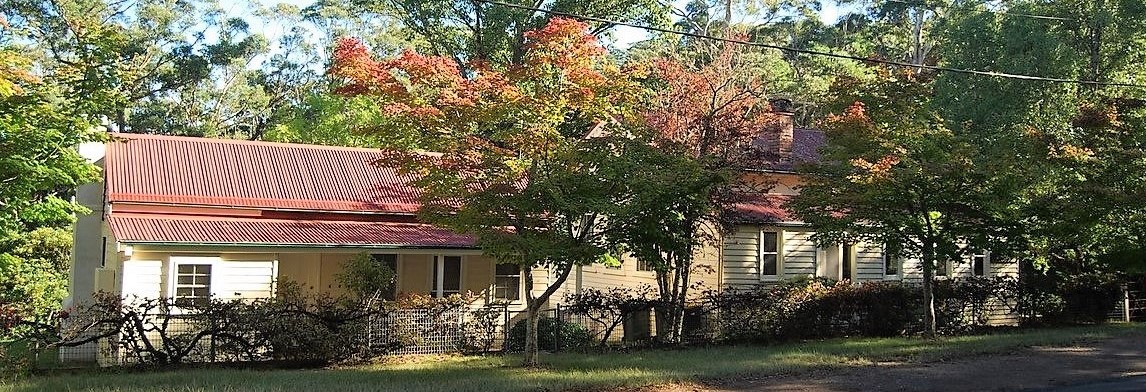 The Old School, Mount Wilson commenced an Artist in Residence program in 2019. This is a volunteer based, not for profit organisation aiming to share the beauty, diversity and tranquility of Mount Wilson, providing an opportunity for artists to work, be supported by and engage with the local community.
The Old School, Mount Wilson commenced an Artist in Residence program in 2019. This is a volunteer based, not for profit organisation aiming to share the beauty, diversity and tranquility of Mount Wilson, providing an opportunity for artists to work, be supported by and engage with the local community.
The program provides residency, accommodation and studio, for one month for both emerging and established artists and suits musicians/composers, writers, visual and textile artists.
Each resident will give a community engagement event.
![]() Artist in Residence on Facebook
Artist in Residence on Facebook
![]()
Artist in Residence on Instagram
Applications are now open and close Friday 31 May
for the October 2024 to June 2025 period.
There is no residency offered for April

|
For more information or to be added to our email list, please contact This email address is being protected from spambots. You need JavaScript enabled to view it.
The Old School Mt Wilson gratefully acknowledges the commitment and generosity of our supporters.
Anne de Salis & Martin Barge
Nancy Fox AM & Bruce Arnold
Steve Gracie
Griffin Foundation
Mary Holt OAM
Joe & Elizabeth Montano
Anon (1)
Please consider making a donation towards the future of the Artists in Residence program at The Old School. Your gift, of any size, is a vital contribution to the program’s future.
All gifts over $2 are fully tax-deductible.
To support The Old School Artists in Residence program, you can:
- Make a direct deposit to:
- Account name: The Old School Mt Wilson Public Fund
- BSB: 082-678
- Account: 31 143 7891
- Email: This email address is being protected from spambots. You need JavaScript enabled to view it.
Please include your name in the description to receive your tax-deductible receipt.
Residencies for November 2023 to June 2024
Ward O'Neill
Johanna Hildebrandt
Frankie Dyson Reilly
Anna Spencer
Peter McLean
Frankie Meaden
Residencies for November 2022 to June 2023
Belle Bregovic emerging poet/classical pianist and guitarist Eitan Muir during their residency will delve deep into their craft and develop new performance works, culminating in a premier performancefor the Mt Wilson local community
Helen Pitt is a senior writer at the Sydney Morning heraldand author of The House, the extraordinary story of the Sydney opera House and the people who built it. This residency will be her first attempt at writing fiction, working on an idea about French female explorers in NSW
Helen Begley is a song writer, composer, performer, teacher and facilitator, currently working on a trilogyof musical performance pieces that explore the stories of femaile immigration to Australia in the 1930s, "Voyage", "Wild" and "Wrecked". During her residency she will be working on "Wild" , the story of immigrant Martha Wild.
Sharon Peoples is a textile artist oscillating between hand and machine embroidery to examine issues. She is energised and draws inspiration from gardens. For her residency she proposes to take time to researchand explore the birds that are present or migrate through the Mt Wilson 'garden'
Anna Glynn artist and Peter Dalmazzo biologist will explore the Blue Mountains basalt forest endangered ecological community creating artwork to focus attention and highlight a stunning and complex environment
Marynes Avila is a multi-award winning artist concerned with socially engaged practice who creates work that specifically responds to site and community
Read the artist statements.......
Residencies for November 2021 to May 2022
Cadance Bell is an author, writer, producer and director.
Brad Gill is a musician and composer
Ariella Van Luyn is a writer
Natasha Dubler is a multidisciplinary artist working across sound installation, music performance and small sculpture.
Anna Glynn artist & Peter Dalmazzo biologist
Jennifer Keeler-Milne is a visual artist.
Read the artist statements here
Residencies for October 2020 to June 2021
Jane Guthleben is a visual artist whose practice involves a fascination with C17th Dutch still life paintings and how to reimagine them in an Australian context
Jody Graham is a multidiscipline artist, whose artwork commemorates loss and memory. Her purpose is to conserve valuable stories and contribute creatively to the Australian bushfire history.
Leah Bullen is a visual artist whose practice explores various locations that recreate and curate the natural world, such as gardens.
Julie Thorndyke is a writer
Read the artists statements......
Residencies for October 2019 to May 2020
LeAnne Vincent a photo based visual artist read more.....
Leisel Mott is a landscape painter
Tristan Coelho composer and Emily Granger harpist
Troth - Amelia Besseney and Cooper Bowman together they fashion ethereal soundscapes from field recordings, vocals, electronics, zither, tape loops and sampled percussion and piano
Mandy Beaumont is a novelist
Lynne Ainsworth will be working on her memoir 'Someone Must Pay'
Read the artists statements......



